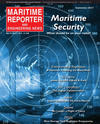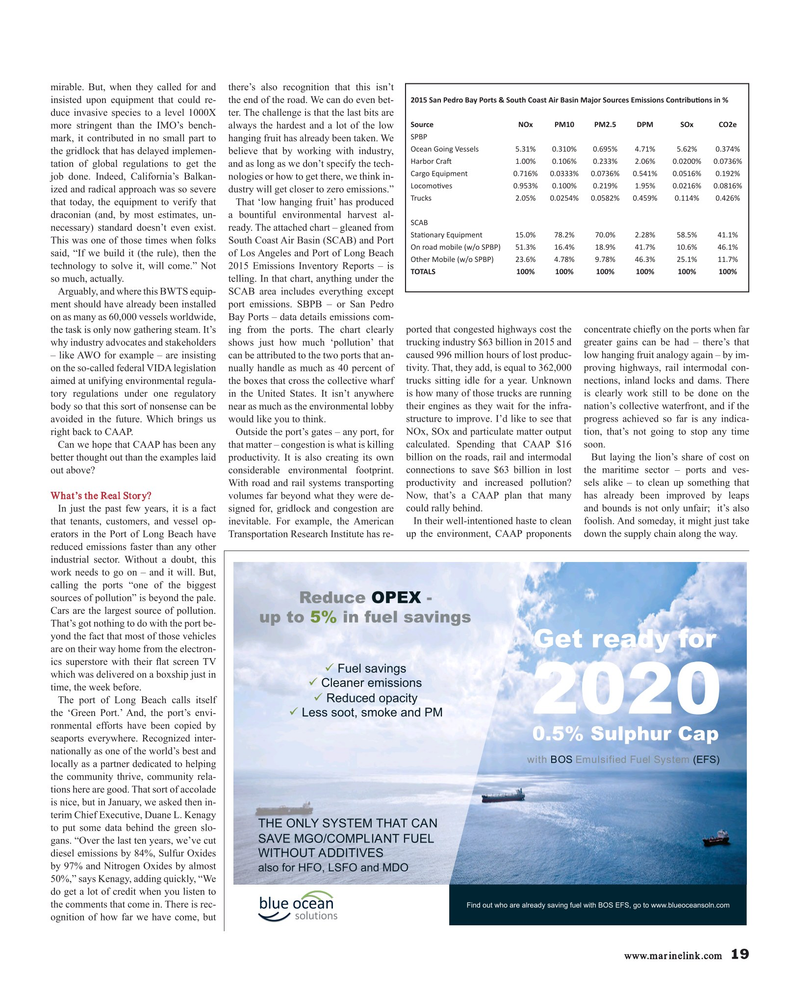
Page 19: of Maritime Reporter Magazine (September 2017)
U.S. Navy Quarterly
Read this page in Pdf, Flash or Html5 edition of September 2017 Maritime Reporter Magazine
mirable. But, when they called for and there’s also recognition that this isn’t 2015 San Pedro Bay Ports & South Coast Air Basin Major Sources Emissions Contribut ons in % insisted upon equipment that could re- the end of the road. We can do even bet- duce invasive species to a level 1000X ter. The challenge is that the last bits are
Source NOx PM10 PM2.5 DPM SOx CO2e more stringent than the IMO’s bench- always the hardest and a lot of the low
SPBP mark, it contributed in no small part to hanging fruit has already been taken. We
Ocean Going Vessels 5.31% 0.310% 0.695% 4.71% 5.62% 0.374% the gridlock that has delayed implemen- believe that by working with industry,
Harbor Craf 1.00% 0.106% 0.233% 2.06% 0.0200% 0.0736% tation of global regulations to get the and as long as we don’t specify the tech-
Cargo Equipment 0.716% 0.0333% 0.0736% 0.541% 0.0516% 0.192% job done. Indeed, California’s Balkan- nologies or how to get there, we think in-
Locomot ves 0.953% 0.100% 0.219% 1.95% 0.0216% 0.0816% ized and radical approach was so severe dustry will get closer to zero emissions.” 0.426% Trucks 2.05% 0.0254% 0.0582% 0.459% 0.114% that today, the equipment to verify that That ‘low hanging fruit’ has produced draconian (and, by most estimates, un- a bountiful environmental harvest al-
SCAB necessary) standard doesn’t even exist. ready. The attached chart – gleaned from
Stat onary Equipment 15.0% 78.2% 70.0% 2.28% 58.5% 41.1%
This was one of those times when folks South Coast Air Basin (SCAB) and Port
On road mobile (w/o SPBP) 51.3% 16.4% 18.9% 41.7% 10.6% 46.1% said, “If we build it (the rule), then the of Los Angeles and Port of Long Beach
Other Mobile (w/o SPBP) 23.6% 4.78% 9.78% 46.3% 25.1% 11.7% technology to solve it, will come.” Not 2015 Emissions Inventory Reports – is
TOTALS 100% 100% 100% 100% 100% 100% so much, actually. telling. In that chart, anything under the
Arguably, and where this BWTS equip- SCAB area includes everything except ment should have already been installed port emissions. SBPB – or San Pedro on as many as 60,000 vessels worldwide, Bay Ports – data details emissions com- the task is only now gathering steam. It’s ing from the ports. The chart clearly ported that congested highways cost the concentrate chie? y on the ports when far why industry advocates and stakeholders shows just how much ‘pollution’ that trucking industry $63 billion in 2015 and greater gains can be had – there’s that – like AWO for example – are insisting can be attributed to the two ports that an- caused 996 million hours of lost produc- low hanging fruit analogy again – by im- on the so-called federal VIDA legislation nually handle as much as 40 percent of tivity. That, they add, is equal to 362,000 proving highways, rail intermodal con- aimed at unifying environmental regula- the boxes that cross the collective wharf trucks sitting idle for a year. Unknown nections, inland locks and dams. There tory regulations under one regulatory in the United States. It isn’t anywhere is how many of those trucks are running is clearly work still to be done on the body so that this sort of nonsense can be near as much as the environmental lobby their engines as they wait for the infra- nation’s collective waterfront, and if the avoided in the future. Which brings us would like you to think. structure to improve. I’d like to see that progress achieved so far is any indica- right back to CAAP. Outside the port’s gates – any port, for NOx, SOx and particulate matter output tion, that’s not going to stop any time
Can we hope that CAAP has been any that matter – congestion is what is killing calculated. Spending that CAAP $16 soon. better thought out than the examples laid productivity. It is also creating its own billion on the roads, rail and intermodal But laying the lion’s share of cost on out above? considerable environmental footprint. connections to save $63 billion in lost the maritime sector – ports and ves-
With road and rail systems transporting productivity and increased pollution? sels alike – to clean up something that
What’s the Real Story? volumes far beyond what they were de- Now, that’s a CAAP plan that many has already been improved by leaps
In just the past few years, it is a fact signed for, gridlock and congestion are could rally behind. and bounds is not only unfair; it’s also that tenants, customers, and vessel op- inevitable. For example, the American In their well-intentioned haste to clean foolish. And someday, it might just take erators in the Port of Long Beach have Transportation Research Institute has re- up the environment, CAAP proponents down the supply chain along the way. reduced emissions faster than any other industrial sector. Without a doubt, this work needs to go on – and it will. But, calling the ports “one of the biggest sources of pollution” is beyond the pale.
Reduce OPEX -
Cars are the largest source of pollution. up to 5% in fuel savings
That’s got nothing to do with the port be- yond the fact that most of those vehicles
Get ready for are on their way home from the electron- ics superstore with their ? at screen TV ? Fuel savings which was delivered on a boxship just in ? Cleaner emissions time, the week before.
? Reduced opacity
The port of Long Beach calls itself 2020 the ‘Green Port.’ And, the port’s envi- ? Less soot, smoke and PM ronmental efforts have been copied by 0.5% Sulphur Cap seaports everywhere. Recognized inter- nationally as one of the world’s best and with BOS Emulsified Fuel System (EFS) locally as a partner dedicated to helping the community thrive, community rela- tions here are good. That sort of accolade is nice, but in January, we asked then in- terim Chief Executive, Duane L. Kenagy
THE ONLY SYSTEM THAT CAN to put some data behind the green slo-
SAVE MGO/COMPLIANT FUEL gans. “Over the last ten years, we’ve cut diesel emissions by 84%, Sulfur Oxides
WITHOUT ADDITIVES by 97% and Nitrogen Oxides by almost also for HFO, LSFO and MDO 50%,” says Kenagy, adding quickly, “We do get a lot of credit when you listen to the comments that come in. There is rec-
Find out who are already saving fuel with BOS EFS, go to www.blueoceansoln.com ognition of how far we have come, but www.marinelink.com 19
MR #9 (18-25).indd 19 MR #9 (18-25).indd 19 9/6/2017 2:46:54 PM9/6/2017 2:46:54 PM

 18
18

 20
20
